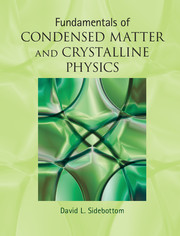 Fundamentals of Condensed Matter and Crystalline Physics
Fundamentals of Condensed Matter and Crystalline Physics from Part III - Dynamics
Published online by Cambridge University Press: 05 August 2012
Introduction
In the last two chapters we explored the behavior of phonons in a crystal. There we saw how these discrete, quantized pieces of propagating energy contributed to both the specific heat and thermal conductivity of the solid. Here we turn our attention to crystalline metals whose metallic bonding results in the formation of a sea of mobile electrons present within the crystal. Like phonons, these mobile electrons carry around energy and consequently contribute to the specific heat. But they also carry around charge and so contribute also to the electrical conductivity of the metal.
In this chapter, we begin with a simplistic model of the mobile electrons as quantum mechanical waves trapped within an infinite square well potential. This model is known as the free electron model because the interaction of the electron with the ion cores of the metal lattice is disregarded. The electron is only trapped by the confines of the crystal itself. Although this simple model is unable to capture all the experimental features of conduction in metals, it readily accounts for the smallness of the electron contribution to the specific heat and does provide a simple interpretation of such electron emission phenomena as the photoelectric effect.
To save this book to your Kindle, first ensure [email protected] is added to your Approved Personal Document E-mail List under your Personal Document Settings on the Manage Your Content and Devices page of your Amazon account. Then enter the ‘name’ part of your Kindle email address below. Find out more about saving to your Kindle.
Note you can select to save to either the @free.kindle.com or @kindle.com variations. ‘@free.kindle.com’ emails are free but can only be saved to your device when it is connected to wi-fi. ‘@kindle.com’ emails can be delivered even when you are not connected to wi-fi, but note that service fees apply.
Find out more about the Kindle Personal Document Service.
To save content items to your account, please confirm that you agree to abide by our usage policies. If this is the first time you use this feature, you will be asked to authorise Cambridge Core to connect with your account. Find out more about saving content to Dropbox.
To save content items to your account, please confirm that you agree to abide by our usage policies. If this is the first time you use this feature, you will be asked to authorise Cambridge Core to connect with your account. Find out more about saving content to Google Drive.